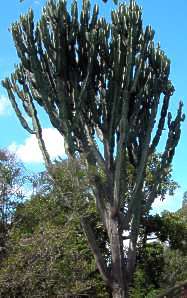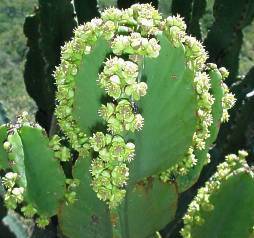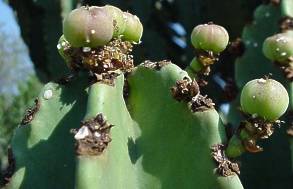Euphorbia ingens
Euphorbia ingens E.Mey. ex Boiss.
Family: Euphorbiaceae
Common names: common tree Euphorbia (Eng.); naboom, gewone naboom (Afr.); mohlohlokgomo, mokgoto (Northern Sotho); unHlonhlo (Sw); Nkondze, Nkonde (Tswana)
SA Tree No: 351
Introduction
If you are looking for a low maintenance addition to a rock or suulent garden this large cactus-like tree is ideal. It is well suited to dry areas and is very attractive with its dark green trunk, yellow to yellow-green flowers and dark red to purple fruits.

Description
Description
An upright, succulent tree with a dark green crown which is well rounded and often shaped like a hot-air balloon. Grows up to 12 m. The branches are segmented with spines running along the ridges of the segments. It produces small, greenish yellow flowers on the ridges of the topmost segment of every branch from autumn to winter. The fruit, a round 3-lobed capsule, turns red to purple when ripening.

Distribution and habitat
Distribution description
This tree prefers warm areas and can survive in areas that go through long periods of drought or are generally very dry. It usually grows on rocky outcrops or in deep sand within bushveld vegetation. Distributed throughout KwaZulu-Natal, Swaziland, Limpopo Province, Gauteng, North-West Province, Mozambique, Zimbabwe and further into tropical Africa.
Derivation of name and historical aspects
History
This family of plants contains herbs, shrubs, trees and succulents. The plants often contain a milky latex or sap that can be extremely harmful. According to Leistner (2000) it contains over 300 genera and over 5 000 species of which 50 genera and 484 species are found in southern Africa. Euphorbia was named after Euphorbus, a 1st century physician to King Juba of Mauritania. The species name ingens means huge.
Ecology
Ecology
The flowers attract butterflies, bees and other insects, which collect pollen and nectar from them, pollinating the trees in the process. The seeds are a good source of food for many fruit and berry eating birds. Birds also like nesting in these trees; hole-nesting birds such as woodpeckers often use dead sections.
Uses
Use
The latex of this tree is extremely toxic and can cause severe skin irritations, blindness and severe illness to humans and animals if swallowed. It is said that cattle driven through these plants can be so severely affected that they have to be put down. If correctly applied it can be medicinally used as a purgative or for the treatment of ulcers. It is said to be used by the Venda and Sotho people as a cure for cancer. Branches are used as a fish poison in South Africa and Zimbabwe. The wood from the main trunk is light and tough and is used to make doors, planks and boats. A fire is made around the tree before it is cut down to set the sap.

Growing Euphorbia ingens
Grow
These plants are easy to grow and make a wonderful addition to a succulent garden or rockery. As it is a succulent it needs little to no maintenance, being a very hardy plant. It does best in the open sun, needing very little water and can therefore withstand periods of drought. Because of its poisonous latex/sap no pests seem to bother these trees.
Please note that though these plants are suitable for gardens, they should not be planted where small children will be playing, as they contain a milky latex/sap that is very harmful if it comes into contact with the skin or eyes and if ingested.
Other euphorbias that can be considered or planted as companion plants to Euphorbia ingens are E. tirucalli (rubber euphorbia) and E. grandidens (valley-bush euphorbia).
References
- Botha, C. & Botha, J. 1995. Bring nature back to your garden. Kohler Carton & Print, Pinetown.
- Leistner, O.A. (ed.). 2000. Seed plants of southern Africa: families and genera. Strelitzia 10. National Botanical Institute, Pretoria.
- Schmidt, E., Lötter, M. & McCleland, W. 2002. Trees and shrubs of Mpumalanga and Kruger National Park. Jacana, Johannesburg. Van Wyk, B-E. & Gericke, N. 2000. People's plants. A guide to useful plants of southern Africa. Briza Publications, Pretoria.
- Van Wyk, B-E., Van Oudtshoorn, B. & Gericke, N. 1997. Medicinal plants of South Africa. Briza Publications, Pretoria.
- Van Wyk, B. & Van Wyk, P. 1997. Field guide to trees of southern Africa. Struik, Cape Town.
Credits
Lou-Nita Le Roux
Lowveld National Botanical Garden
July 2004
Plant Attributes:
Plant Type: Succulent, Tree
SA Distribution: Gauteng, KwaZulu-Natal, Limpopo, Mpumalanga, North West
Soil type: Sandy
Flowering season: Autumn, Winter
PH: Acid, Alkaline, Neutral
Flower colour: Green, Yellow
Aspect: Full Sun
Gardening skill: Easy
Special Features:
Horticultural zones










Rate this article
Article well written and informative
Rate this plant
Is this an interesting plant?
Login to add your Comment
Back to topNot registered yet? Click here to register.